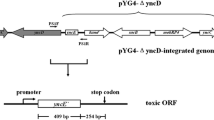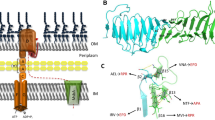Summary
A sequence (hlyR) of about 600 bp which enhances the expression of hemolysin (HlyA) more than 50-fold was identified in the plasmid pHly152-specific hemolysin (hly) determinant. Deletion of this entire hlyR sequence led to the same low level of hemolysin synthesis and excretion as that expressed by the recombinant plasmid pANN202-312. HlyR was active in cis but its activity was orientation-dependent. The enhancing sequence, hlyR, is separated from the promoter phlyI transcribing hlyC, hlyA and possibly hlyB by more than 1.5 kb including an IS2 element. Stepwise removal of the hlyR sequence from its 5′ end by exonuclease III (ExoIII) digestion yielded several types of deletion mutants which expressed decreasing amounts of hemolysin. A similar observation was made when hlyR was shortened by ExoIII from its 3′ end, which suggests that more than one functional region may be present in the hlyR sequence. A deletion of 717 bp within the adjacent IS2 element reduced the activity of hlyR only slightly, indicating that IS2 is not directly involved in the enhancement mechanism but that it may support an optimal positioning in hlyR relative to the hly promoter. The nucleotide sequence of hlyR is rich in A+T and does not contain an extended open reading frame, but exhibits several sequence motives that may represent sites for protein binding and DNA bending.
Similar content being viewed by others
References
Barsomian G, Lessie TG (1987) IS2 activates the ilvA gene of Pseudomonas cepacia in Escherichia coli. J Bacteriol 169:1777–1779
Brosius J, Walz A (1982) DNA sequences flanking an E. coli insertion element IS2 in a cloned yeast TRP5 gene. Gene 17:223–228
Cavalieri SJ, Bochach GA, Snyder IS (1984) Escherichia coli α-hemolysin: characterization and probable role in pathogenicity. Microbiol Rev 48:326–343
Dandanell G, Valentin-Hansen P, Love Larsen JE, Hammer K (1987) Lohg-range cooperativity between gene regulatory sequences in a procaryote. Nature 325:823–826
Ebright RH, Cossart P, Gicquel-Sanzey B, Beckwith J (1984) Mutations that alter the DNA sequence specificity of the catabolite gene activator protein of E. coli. Nature 311:232–235
Felmlee T, Pellet S, Welch RA (1985) Nucleotide sequence of an Escherichia coli chromosomal hemolysin. J Bacteriol 163:94–105
Gardner JF, Nash HA (1986) Role of Escherichia coli IHF protein in lambda site-specific recombination. A mutational analysis of binding sites. J Mol Biol 191:181–189
Goebel W, Hedgpeth J (1982) Cloning and functional characterization of the plasmid-encoded hemolysin determinant of Escherichia coli. J Bacteriol 151:1290–1298
Gonzalez-Carrero MI, Zabala JC, Dela Cruz F, Ortiz JM (1985) Purification of α-hemolysin from an over-producing E. coli strain. Mol Gen Genet 199:106–110
Hacker J, Hughes C (1985) Genetics of Escherichia coli hemolysin. Curr Top Microbiol Immunol 116:1–162
Henikoff S (1984) Unidirectional digestion with exonuclease III creates targeted breakpoints for DNA sequencing. Gene 28:351–359
Hess J, Wels W, Vogel M, Goebel W (1986) Nucleotide sequence of a plasmid-encoded hemolysin determinant and its comparison with a corresponding chromosomal hemolysin sequence. FEMS Microbiol Lett 34:1–11
Juarez A, Hughes C, Vogel M, Goebel W (1984) Expression and regulation of the plasmid-encoded hemolysin determinant of Escherichia coli. Mol Gen Genet 197:196–203
Knapp S, Then I, Wels W, Michel G, Tschäpe H, Hacker J, Goebel W (1985) Analysis of the flanking regions from different haemolysin determinants of Escherichia coli. Mol Gen Genet 200:385–392
Ludwig A, Vogel M, Goebel W (1987) Mutations affecting activity and transport of haemolysin in Escherichia coli. Mol Gen Genet 206:238–245
Mackman N, Holland JB (1984) Secretion of a 107 K dalton polypeptide into the medium from a hemolytic E. coli K12 strain. Mol Gen Genet 193:312–315
Marini JC, Levene SD, Crothers DM, Englund PT (1982) Bent helical structure in kinetoplast DNA. Proc Natl Acad Sci USA 79:7664–7668
Mossing MC, Record MT (1986) Upstream operators enhance repression of the lac promoter. Science 233:889–892
Mukherjee IP, Bastia D (1985) Conformational changes in a replication origin induced by an initiator protein. Cell 43:189–197
Noegel A, Rdest U, Goebel W (1981) Determination of the functions of hemolytic plasmid pHly152 of Escherichia coli. J Bacteriol 145:233–247
Peterson PA, Ghosal D, Sommer H, Saedler H (1979) Development of a system useful for studying the formation of unstable alleles of IS2. Mol Gen Genet 173:15–21
Prentki P, Chandler M, Galas DJ (1987) Escherichia coli integration host factor bends the DNA at the ends of IS1 and in an insertion hotspot with multiple IHF binding sites. EMBO J 6:2479–2487
Reitzer LJ, Magasanik B (1986) Transcription of glnA in E. coli is stimulated by activator bound to sites far from the promoter. Cell 45:785–792
Reynolds AR, Felton J, Wright A (1981) Insertion of DNA activates the cryptic bgl operon in E. coli K12. Nature 293:625–629
Reynolds AR, Mhadevan S, LeGrice SFJ, Wright A (1984) Enhancement of bacterial gene expression by insertion elements or by mutation in a CAP-cAMP binding site. J Mol Biol 191:85–95
Ronecker HJ, Rak B (1988) Genetic organization of insertion element IS2 based on a revised nucleotide sequence. Gene (in press)
Saedler H, Reif HJ, Hu S, Davidson N (1974) IS2, a genetic element for turn-off and turn-on of genetic activity in E. coli. Mol Gen Genet 132:265–272
Sanger F, Nicklen S, Coulson AR (1977) DNA sequencing with chain-terminating inhibitors. Proc Natl Acad Sci USA 74:5463–5467
Schnetz K, Toloczyki C, Rak B (1978) β-Glucoside (bgl) operon of Escherichia coli K-12: Nucleotide sequence, genetic organization, and possible evolutionary relationship to regulatory components of two Bacillus subtilis genes. J Bacteriol 169:2579–2590
Springer W, Goebel W (1980) Synthesis and secretion of hemolysin by E. coli. J Bacteriol 144:53–59
Wagner W, Vogel M, Goebel W (1983) Transport of hemolysin across the outer membrane of Escherichia coli requires two functions. J Bacteriol 154:200–210
Wagner W, Kuhn M, Goebel W (1988) Active and inactive forms of hemolysin (HlyA) from Escherichia coli. Biol Chem Hoppe Seyler 369:39–46
Wood AG, Konisky J (1985) Activation of a cloned archaebacterial gene in Escherichia coli by IS2, IS5 or deletions. Mol Gen Genet 198:309–314
Wu HM, Crothers DM (1984) The locus of sequence-directed and protein-induced DNA bending. Nature 308:509–513
Zinkel SS, Crothers DM (1987) DNA bend direction by phase sensitive detection. Nature 328:178–181
Author information
Authors and Affiliations
Additional information
Communicated by E. Bautz
Rights and permissions
About this article
Cite this article
Vogel, M., Hess, J., Then, I. et al. Characterization of a sequence (hlyR) which enhances synthesis and secretion of hemolysin in Escherichia coli . Molec. Gen. Genet. 212, 76–84 (1988). https://doi.org/10.1007/BF00322447
Received:
Issue Date:
DOI: https://doi.org/10.1007/BF00322447




